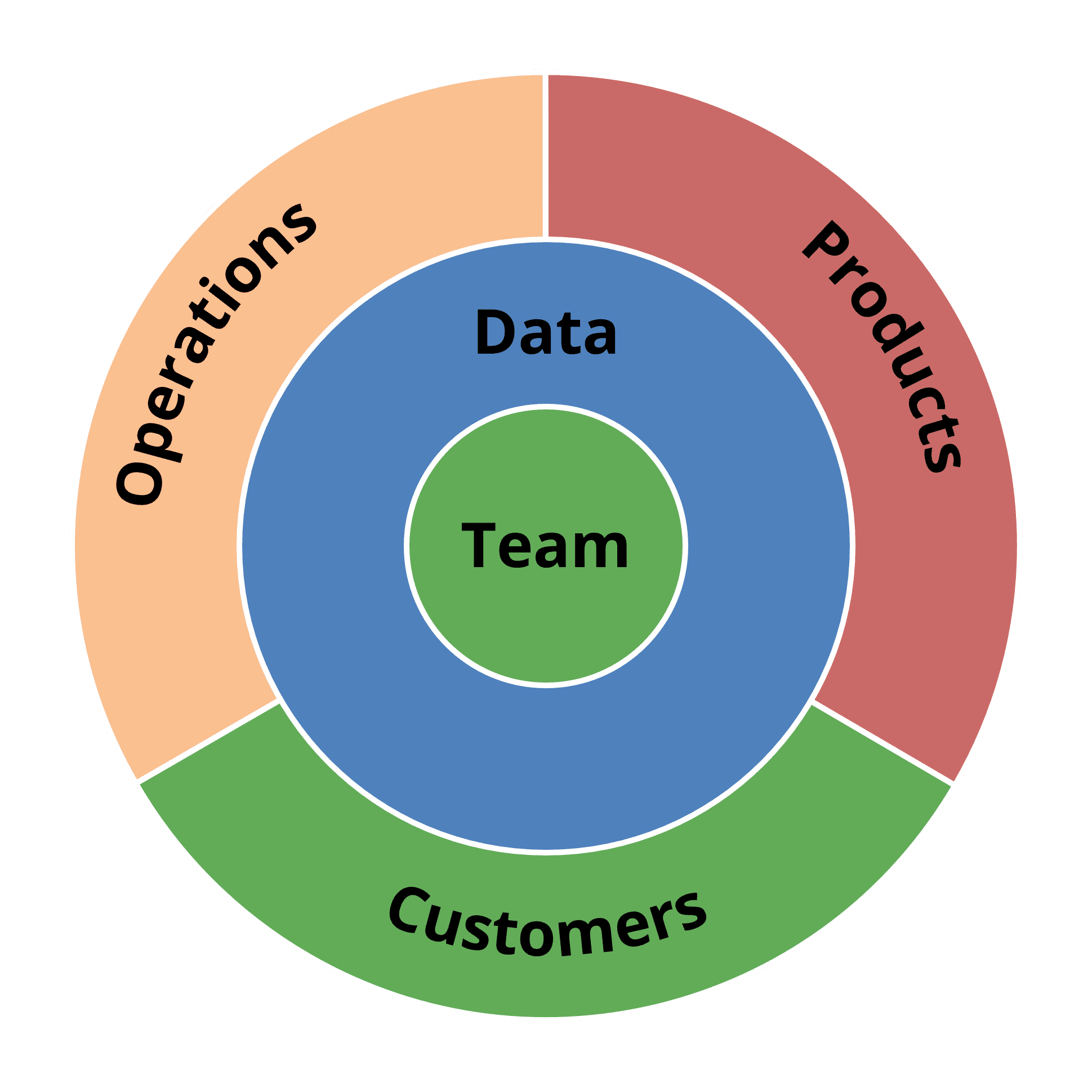Discover a powerful mental model for a Connected Business, breaking down organizational silos and driving innovation where it matters most—at the intersection points. Learn how the 5 Building Blocks framework helps leaders navigate transformation and integrate AI across their business for exponential value creation.
There’s a dangerous myth in the business world that innovation belongs to the lone genius – the brilliant mind working in isolation who suddenly cracks the code that everyone else missed.
In reality? The magic happens at the intersections.
After 40+ years leading strategic initiatives across industries, I’ve seen firsthand that the most valuable innovations emerge when different domains connect. When Manufacturing talks to Marketing. When IT collaborates with Product Development. When Finance and Operations share the same view of reality.
That’s why I’ve spent years refining a framework that helps organizations navigate as new and transformative ideas, innovations, and technologies appear: The 5 Building Blocks of a Connected Business.
Like Lego pieces that snap together to create something greater than their parts, these building blocks give you a mental model for seeing beyond silos and finding the connection points where real value emerges.
The framework has evolved since I first introduced it (back when “digital transformation” was the hot buzzword), but its core purpose remains: helping you map any business challenge or opportunity in a way that reveals where collaboration creates exponential value.
Today, as AI reshapes every aspect of how we work, this interconnected approach matters more than ever.
The 5 Building Blocks Framework

Every organization – regardless of size, industry, or maturity – can be understood through these five fundamental building blocks:
Operations Excellence
The systems and processes powering your daily business. This is the mature foundation where most organizations have invested heavily in automation and optimization. Operational Excellence encompasses everything from core accounting processes to manufacturing execution and supply chain management.
What makes this building block unique is how it drives consistency, efficiency, and control. When working well, it creates the stability that allows your business to scale while maintaining quality. These internal processes have typically been the first to adopt technology, with decades of evolution from ledger books to cloud platforms.
The challenge now isn’t just automation – it’s bringing intelligence to these processes so they can predict, adapt, and self-optimize. This is where you turn strategy into consistent execution that creates a sustainable competitive advantage.
Customer Connection
The touchpoints and relationships that bridge your organization to your markets. This building block represents all of your customer-facing capabilities – from marketing communications and sales processes to service delivery and experience design.
Unlike the structured environments of internal operations, Customer Connection thrives on design thinking, emotional intelligence, and deep understanding of human behavior. The systems here – CRM platforms, digital marketing tools, e-commerce – focus on creating seamless, satisfying experiences that build loyalty and drive growth.
The most effective organizations recognize that customer connection isn’t just a marketing function; it requires the entire organization to align around customer needs and journey maps. This is where you translate customer needs into meaningful experiences and lasting value that keeps them coming back.
Products and Services
The innovation engine that creates and evolves what you sell. Whether you produce physical goods, digital offerings, or services, this building block represents everything that goes into conceiving, designing, delivering, and supporting your products.
In the past, product development might have been isolated from both operations and customer feedback. Today’s connected products incorporate intelligence at their core – they gather data, learn from usage, and continuously improve. The addition of sensors, connectivity, and AI has fundamentally transformed how products create value.
For many organizations, this shift from static to intelligent products represents the most profound change in their business model, opening new revenue streams and deeper customer relationships. This is where you embed intelligence and differentiation that creates sustainable market advantage.
In many companies, these three core areas of the business have been loosely connected (at best). But when we tightly integrate with free-flowing, consistent, detailed information between operations, customer service, marketing, engineering, and new product development, all three of these areas will see significant improvements – in productivity, customer satisfaction, and revenue growth.
Okay, a significant step forward – but we’re not done yet. Functional transformation and integration is not quite enough; relying on integrated, consistent data flowing through all systems is one thing, but leveraging that data for insights and opportunities doesn’t come automatically. A really, really Connected Business will also target how people work, and how people work together:
Data and Analytics
The capability to transform raw information into actionable insights. While data flows through the other building blocks, “data mastery” represents your organization’s ability to purposefully collect, analyze, visualize, and apply information to drive better decisions.
This building block encompasses both the technical capabilities (data warehouses, analytics platforms, intelligence tools) and the human skills (data literacy, analytical thinking, pattern recognition) needed to create value from information. It’s not enough to accumulate data; organizations must develop systematic ways to turn it into intelligence.
The most data-mature organizations have progressed from descriptive analytics (“what happened?”) through predictive (“what might happen?”) to prescriptive (“what should we do about it?”). This is where you build the foundation for evidence-based decisions that create strategic advantage.
Human Factors – Building Great Teams
The human element that makes everything else work. This final building block represents your organization’s ability to build diverse, high-performing teams with the skills, mindsets, and collaborative capabilities needed for connected business.
Team dynamics encompasses everything from talent acquisition and development to leadership practices, communication patterns, and incentive systems. While technology enables connection, only humans can create the trust, creativity, and shared purpose that make connection meaningful.
This building block has faced profound disruption with remote work, distributed teams, and AI augmentation changing how we collaborate. Organizations that thrive recognize that human intelligence, creativity, and empathy remain irreplaceable – but can be dramatically amplified by technology. This is where you create the conditions for sustainable innovation and adaptability.
Why This Framework Matters Now
Back when I first developed this framework, organizations were still wrestling with basic connectivity – getting systems to talk to each other, breaking down departmental silos, creating more seamless customer experiences.
Those challenges haven’t disappeared. But now we’re facing something more profound: the integration of artificial intelligence across every building block.
AI isn’t just another technology tool – it’s a fundamental shift in how each building block functions and how they connect to each other:
- Operations aren’t just automated; they’re predictive and self-optimizing
- Customer connections aren’t just personalized; they’re contextually aware in real-time
- Products aren’t just smart; they’re continuously learning and adapting
- Data isn’t just analyzed; it’s transformed into intelligence that drives autonomous decisions
- Teams aren’t just collaborative; they’re augmented with AI capabilities that amplify human potential
The organizations thriving through this transition aren’t the ones with the most advanced AI. They’re the ones who understand how to integrate AI across all five building blocks in a coherent, connected way.
Building Blocks in Practice
Consider how this plays out with a manufacturer I recently worked with. Their initial AI exploration looked like most companies – disconnected pilots in different departments. Marketing was implementing a generative AI tool for content creation. Operations was testing predictive maintenance. Product development was exploring AI-driven design tools.
Each initiative showed promise, but the real breakthrough came when they started connecting these efforts across building blocks:
- The predictive maintenance system in Operations began feeding data to Product Intelligence, helping engineers understand how design choices affected longevity in the field
- The customer behavior patterns identified by Customer Connection systems informed Data Mastery initiatives, revealing patterns that led to product innovations
- Team Dynamics shifted as cross-functional groups formed around these connection points, collaborating in new ways that broke down traditional silos
The result wasn’t just incremental improvement in each area – it was exponential value creation at the intersections.
Finding Your Connection Points
The real power of this framework comes when you use it as a map to locate yourself in the larger ecosystem of your business.
Ask yourself:
- Which building block represents my primary focus?
- What knowledge and capabilities do I bring to that building block?
- Which adjacent building blocks most impact my success?
- Where are the connection points where I can collaborate across boundaries?
- How might AI transform both my building block and its connections to others?
This mental model works whether you’re a CEO orchestrating enterprise transformation or a mid-level professional trying to understand how your role fits into the bigger picture.
The Path Forward
Over the next few weeks, I’ll be diving deeper into each building block – exploring how AI is transforming each one and revealing the connection points where the most value is created.
For now, I encourage you to think about your own context:
- Which building blocks are strongest in your organization?
- Where do you see the most disconnection or friction?
- How might stronger connections between building blocks unlock new value?
- What’s one small step you could take to strengthen a key connection point?
Business transformation isn’t about isolated brilliance. It’s about seeing the building blocks, understanding their connections, and finding the intersection points where innovation emerges.
That’s where the magic happens – not in isolation, but in connection.
What building block is most critical in your organization today? Drop a comment below, and let’s explore how it connects to the others.
—
This post is part of a series exploring The 5 Building Blocks of Connected Business. Next week, we’ll dive deeper into Operational Excellence and how AI is transforming how we execute our core business functions.
—
Want more insights on AI and other ways to create value? Join our mailing list for exclusive analysis on the future of startup investment, sustainable innovation, and the intersection of technology and business.
20 May, 2025


Comments (2)
Love it Jim. happy to do some mapping exercises with you for the two organizations I’m currently working with – a charity and a small business. I can see how this framework would apply/benefit both.
Over a club soda, I’d also like to debate with you the merits of breaking “partners” out of operations in the outer ring. 😉
Mikw! thanks for the comment!
Hmm, that’s interesting. A company’s trading partners up-and-down they value chain are a key part of every company. And you are right to see them in Operations, because I am thinking of partners on the supply side as well as the demand side.
Definitely a good reason to connect over club soda … or pancakes …